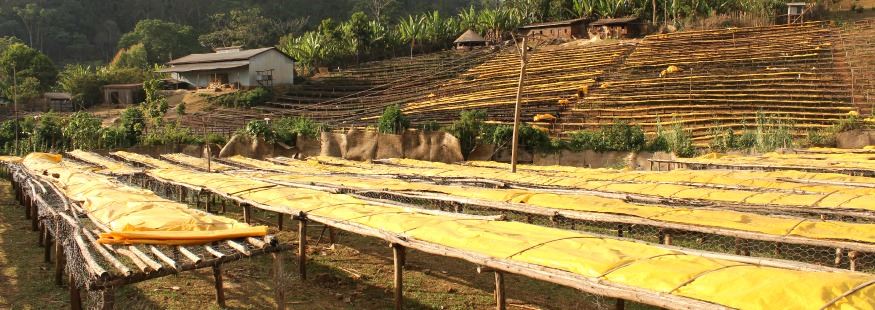Origin Trip: Ethiopia

Published in the April issue of Cafe Culture Magazine, Guy shares his experiences and insights of the birthplace of coffee from a recent origin trip to Ethiopia.
Travelling to origin is a rewarding experience for anyone in the coffee industry. We travel to origin for many reasons. Primarily, to connect face-to-face with producer partners and broaden our sourcing tendrils; but more importantly, to deepen our understanding of this dynamic industry we are a part of.
Where better to go to further our knowledge than the birthplace of coffee itself; Ethiopia.
Ethiopia is a steady origin on our annual itinerary and never ceases to impress. Coffee is embedded in the culture of the country and has forged strong ties with the people of Ethiopia over its history. Coffee provides a livelihood for 1 in 4 people in Ethiopia. It is an integral part of the economy and accounts for 60 percent of export earnings. With the export economy so heavily invested in coffee, Ethiopia finds itself in a precarious position. A slight shift in supply and demand - a decline in production due to a poor harvest or an increase in global excess supply for example - can considerably affect export earnings and quickly upset this already negative balance of trade.
Nearly 98 percent of coffee grown in Ethiopia is produced by smallholder producers, farming on average less than a hectare of land. The remaining is produced by State owned farms. Approximately 30 percent of coffee produced in Ethiopia is processed using the washed method, with the remaining 70 percent processed using the traditional natural method.
Smallholder farmers deliver their coffee in cherry form to local washing stations during the season and are paid by total weight. Generally there are three harvests during the season, however this year most of the coffee ripened at the same time requiring farmers to pick feverishly to ensure all the coffee cherry was picked at optimum colour. When a farmer delivers coffee to a washing station notations are made regarding weight, farmer details, farm location etc. and at the end of the season the notes will be tallied and farmers will receive payment. For farmers who are not able to reach a washing station, there are collection depots where cherry can be delivered and is then transferred to the nearest station.
Coffees bound for the washing tanks are pulped using a machine with three disc burrs that are set to a specific grade to ensure that the skin of the cherry is removed without damaging the bean inside. Once the coffee has been de-pulped it is transferred to fermentation tanks to break down the sticky mucilage that surrounds the bean and parchment layer. Fermentation times vary between 24-36 hours depending on the weather. Once this process is complete, the coffee is transferred to soaking tanks for up to 10 hours to remove any fermentation residue. The clean parchment is then swiftly and evenly distributed over raised drying beds and left for 10 to 15 days until it reaches the desired moisture level.
Naturally processed coffees are kept in whole cherry form and transferred directly onto raised drying beds, allowing the sticky mucilage to be absorbed into the coffee bean producing the sweet fruity flavours that natural coffees are renowned for. The drying process for natural coffees takes between 21 to 30 days.
The highlight of this visit was a week spent in the famed growing region of Yirgacheffe in southern Ethiopia. We have been sourcing coffee from this region for many years and it is home to some of the best cup profiles in the country. I was disappointed to learn that the current season in Yirgacheffe has been poor, with farmers experiencing significant volume reductions of up to 30 percent. These reductions have prompted upward pressure on the price paid to farmers and washing stations are paying up to 20 birr (Ethiopian currency) per kilogram of cherry, almost double the price that was paid last season.
Nearly all Ethiopian coffee is traded through the Ethiopian Commodity Exchange (ECX). Only cooperatives, unions and licensed farm owners are able to export directly to the international market, so the majority of the coffee that is exported to consuming countries is via the ECX.
Introduced in 2008, the goal of the ECX is to empower farmers and increase financial gain. By centralising the export market, the ECX claim to be connecting buyers and sellers in an efficient, reliable and transparent global commodity market. The problem with this model is that it does not allow for the detailed traceability and transparency that is sought after in the emerging specialty coffee market.
This model also makes sourcing consistent quality and supply through the ECX somewhat hit and miss. Coffees are blended and regional flavour attributes are blurred. Identifiable lots are consolidated and traceability is lost. The ECX have a quality team who grade and cup every lot of coffee that passes through the system. This information, in addition to the region, is the only detail that is offered to potential buyers in the market. Exporters are asked to bid at auction on coffee lots they have not been able to sample and as such have no assurance as to quality or provenance. It is only after a coffee has been purchased that a sample may be drawn for evaluation and to, ultimately, determine its market potential.
Discussions within the Ethiopian coffee industry suggest that there are potential changes forthcoming to the way the ECX is currently operating, specifically in regards to specialty coffee. These changes may be a few years away, however it has been suggested that authorities are slowly realising that exporting coffee like other agricultural commodities does not promote the effective marketing of Ethiopian coffee.
It seems that the spread of globalisation had hastened since my last visit to the country 12 months ago. This trip included visits to areas of Ethiopia that were previously unknown in the wider industry, where coffee farmers have formerly catered solely to the domestic market. The increase in global communication has facilitated a wave of information, carrying quality and market knowledge to farmers across the country.
It seems that the ECX has attempted to adapt to these developments, however it is clear the processes in place are inadequate. The lack of traceability and inconsistent quality have caused issues for exporters who are catering to a quality focused market. These admissions are beginning to surface and it will be interesting to watch the progression of the system over the coming years.
Bennetts have been sourcing Ethiopian coffee for over a decade. Some of our longest standing cooperative and export partners hail from the origin and we are proud to have established a solid reputation within the Ethiopian coffee industry. While washed coffees have historically had a larger appeal in the Australian market, the recent trend towards fruity natural coffees have seen us begin to import a wide range of natural Ethiopians. This trip has seen us break new sourcing ground and we are looking forward to exploring these new opportunities.
Ethiopia is a diverse and multi-faceted origin, faced with many challenges but also opportunities ahead, and it is definitely one to watch. Many times during the trip I was told to remember TIA – This is Africa! If you can conceive something happening, it probably will or already has!
First published in Cafe Culture Magazine Issue 39, April 2015.


